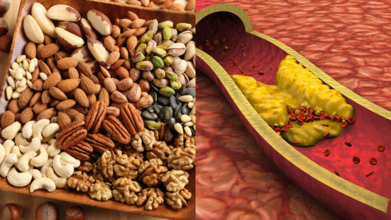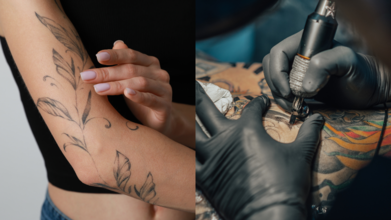- Health Conditions A-Z
- Health & Wellness
- Nutrition
- Fitness
- Health News
- Ayurveda
- Videos
- Medicine A-Z
- Parenting
- Web Stories
Dermatologist Reveals What To Add And Remove From Skincare Routine For Season Change

Image Credit: Canva
The sudden change in weather from winter to spring wrecked my skin. One moment, it was so clear and smooth; the next morning, my skin broke out with acne across my cheeks and forehead. The higher humidity left my skin oily, but also dry in spots. Regardless of how much I cleansed and moisturized, the acne did find a way to return. Frustrated and defeated, I went and spoke to my dermat who told me that changes in seasons disrupt the skin balance. With a few adjustments—changing to a mild cleanser, incorporating a hydrating serum, and applying SPF every day—my skin gradually adjusted. I now understand that seasonal skincare adjustments are equally crucial with your skincare routine.
As seasons change, so do your skin's requirements. Temperature changes, humidity levels, and environmental aggressors can make your skin dry, irritated, or even breakout-prone. While winter’s dry air can strip away moisture, summer’s humidity may increase oil production, making your skin feel greasy and congested. To maintain a radiant and healthy complexion year-round, adapting your skincare routine is crucial. Leading dermatologists, including Dr. Kiran Sethi, MD, an Integrative Aesthetic and Celebrity Skin Expert, emphasize the importance of seasonal skincare adjustments to keep skin balanced and glowing.
Your skin is your body's biggest organ, serving as a protective barrier against environmental elements such as extreme weather, pollution, and UV rays. Seasonal changes can interfere with this barrier, causing issues like dryness, irritation, and even long-term skin conditions like eczema and psoriasis. For sensitive skin, seasonal changes can cause flare-ups, so it is even more important to adjust your skincare routine accordingly. Dermatologists are of the opinion that even people without existing skin problems can reap rewards from seasonal changes in skincare.
1. Apply a Mild Cleanser and Moisturize Daily
Cleaning is the key to any skincare regimen, but harsh cleansers can rob the skin of its vital oils, particularly when the weather becomes dry. Dr. Kiran Sethi suggests making the switch to a sulfate-free cleanser that contains moisturizing agents such as glycerin and aloe vera to wash away dirt without disrupting the skin's moisture barrier.
Hydration is also a necessity. Use a moisturizer that is packed with hyaluronic acid, ceramides, and niacinamide, which all collaborate to seal in moisture, strengthen the skin barrier, and smoothen out the complexion. Moisturizing right after washing your face gives your skin an optimal absorption rate and long-lasting hydration.
2. Exfoliate and Boost with Vitamin C
Exfoliating is the key to smooth, glowing skin. Exfoliating once or twice a week using a gentle chemical exfoliant like glycolic or lactic acid can strip away dead skin cells and prevent dullness without irritating the skin. Exfoliating too much can deplete the skin's barrier function, so everything must be done in moderation.
Adding a vitamin C serum (ideally with 10–20% concentration) to your skincare routine can yield added skin-lightening benefits. Vitamin C is an antioxidant that fights free radicals and causes premature aging. Dr. Sethi recommends using those products that contain ferulic acid and vitamin E, as they increase the efficacy of vitamin C and help overall skin clarity.
3. Use Sunscreen Daily
Most individuals incorrectly assume that sunscreen is only needed in the summer. UV rays can pass through clouds and damage skin throughout the year. A broad-spectrum sunscreen with SPF 30 or more, with zinc oxide or titanium dioxide, is needed for everyday protection.
In colder weather, cream sunscreens provide extra hydration, keeping the skin from becoming dry and scaly. Reapply sunscreen every two hours outdoors to maintain the protection against damage from UV radiation and premature aging.
4. Advanced Skincare Treatments for Hydration and Firmness
For individuals who need a boost in their skincare regime with professional procedures, bio-remodeling treatments such as Profhilo provide intense hydration and enhanced elasticity. This new treatment makes use of ultrapure hyaluronic acid that stimulates the production of collagen and elastin and makes the skin smoother and firmer.
Another cutting-edge choice is hydrostretch therapy with Viscoderm Hydrobooster, which has stabilized hyaluronic acid to soften fine lines and deliver deep hydration from the inside out. These treatments, in conjunction with a robust daily skincare regimen, can effectively fight seasonal changes and keep skin healthy.
5. Fortify Your Skin's Barrier for Long-Term Protection
Your skin barrier is your first line of defense against cold weather, pollution, and allergens. Protecting it with the proper ingredients is key to having a robust, healthy-looking complexion.
Dr. Sethi suggests products with ceramides, peptides, cholesterol, and essential fatty acids such as linoleic acid. These ingredients synergistically strengthen the skin barrier, trapping moisture and keeping external irritants from damaging the skin. When the skin barrier is healthy, it is less prone to seasonal dryness, irritation, and breakouts.
While these tips from dermatologists are a good starting point for making your skincare routine seasonal, skincare is not a one-size-fits-all affair. Skin type, lifestyle, and local climate are factors that should affect your strategy. A dermatologist can assist you in customizing your routine to meet your individual concerns, yielding the best results year-round.
Dr Kiran Sethi, MD is a Integrative Aesthetic And Celebrity Skin Expert, Founder and Medical Director at Isya Aesthetics, New Delhi in India
What Is Pulmonary Fibrosis and Why That Annoying Cough Might Be More Than Just a Cold

Credits: Canva
If you’ve been coughing for weeks, blaming it on “lingering winter sniffles” or chalking it up to “just getting older,” it might be time to step away from the cough syrup and lean in for some uncomfortable truth. Your cough could be more than a seasonal annoyance. In rare but serious cases, it could be a red flag for a life-limiting condition called pulmonary fibrosis.
What is Pulmonary Fibrosis?
In plain terms, “pulmonary” means lungs, and “fibrosis” means scarring. It’s a serious, progressive condition where lung tissue becomes scarred and stiff, making it increasingly hard to breathe.
Reportedly, there’s currently no cure. Treatments exist, but they mainly slow down the damage rather than reverse it. The sooner you get diagnosed, the better your chances of managing symptoms and that’s where spotting the signs early is crucial.
Symptoms to Watch For
- Shortness of breath (especially when climbing stairs or speed-walking to catch the bus)
Why That Cough Happens
Coughing is your body’s bouncer, booting out anything that might harm your lungs — dust, smoke, rogue crumbs, the works. The process involves your vocal cords clamping shut, then snapping open with a burst of air.
With pulmonary fibrosis, this reflex can get stuck on a loop. Coughing irritates the vocal cords, which makes you cough more, which irritates them further, a vicious cycle that can turn even a quiet cup of tea into a coughing fit.
The Four Flavours of Cough
- Acute cough – Lasts less than three weeks; often tied to infections or irritants.
Coughs can also be:
- Dry/unproductive – Triggered by things like temperature changes, dusty air, or laughing.
Who’s More at Risk?
While pulmonary fibrosis can happen to anyone, your risk might be higher if you:
- Are over 50
Managing the Cough
A pulmonary fibrosis cough often doesn’t respond to standard cough medicines. Instead, treatment usually focuses on easing symptoms and improving quality of life.
Your doc may recommend alternative medications used for chronic cough in other conditions. These don’t cure the scarring but can make the coughing less intrusive. They’ll also want to check for other contributing factors like acid reflux, sinus issues, or side effects from medication, because if those are making things worse, tackling them can help.
Everyday Coping Tricks
While you work with your doctor, you can try a few lifestyle tweaks to manage coughing fits:
- Avoid smoky, dusty, or heavily polluted spaces
Pulmonary fibrosis is rare, but catching it early can mean more treatment options and better management. Plus, you’ll finally know whether your cough is from a stubborn cold or something that needs closer attention. Your cough could be a harmless side effect of a dusty ceiling fan or it could be your body waving a red flag.
Scientist Reveals the Tiny Foods That Can Transform Your Cholesterol in Just 10 Days

If you’ve ever stared at a packet of mixed nuts wondering whether to sprinkle them over your porridge or just eat them by the handful, here’s your permission slip: go for it. According to Dr Sarah Berry, a professor at King’s College London and Chief Scientist at ZOE, nuts and seeds are not just snackable; they are good for cholesterol crunching. In fact, swap some of your less healthy fats for these nutritional powerhouses, and you could lower your cholesterol by up to 10 per cent in just 10 days. That is faster than most fad diets.
The 10-Day Cholesterol Challenge
High cholesterol often feels like one of those invisible problems, until it suddenly is not. It can quietly build up in your arteries, increasing the risk of heart attacks and strokes. But Dr Berry, during an appearance on the Zoe podcast, said that you can make a real difference in under two weeks by tweaking, not overhauling, your diet. It’s not about eating less fat; it’s about eating the right kind of fat.
And this is where most people get it wrong. “Don’t do a low-fat diet,” Dr Berry warns, calling the idea “radical” to anyone still following decades-old advice. Instead, aim for a moderate-fat diet rich in polyunsaturated and monounsaturated fats—exactly the kinds you’ll find in nuts, seeds, and certain oils.
Why Low-Fat Diets Miss the Point
It is tempting to think cutting fat will cut cholesterol, but Dr Berry explains that’s a trap. Not all fats are bad. Saturated fats, found in red meat and some processed foods, can push LDL cholesterol—often dubbed “bad” cholesterol—into dangerous territory. But polyunsaturated fats, abundant in seeds, seed oils, and many nuts, do the opposite.
Simply adding nuts to your meals, whether as a snack, salad topping, or nut butter, can slash LDL cholesterol by 5 to 10 per cent. You have to make a swap. This benefit comes from replacing “harmful” fats, like those in certain animal products and fried foods, with healthier plant-based fats.
Seeds: The Cholesterol Fighters
Sunflower seeds, flaxseeds, chia seeds—they’re all loaded with polyunsaturated fatty acids that support heart health. Stir them into yoghurt, blend them into smoothies, or scatter them over roasted veggies. You’ll barely notice the extra effort, but your arteries will thank you.
Seed oils, like sunflower and flaxseed oil, can also be smart choices in moderation, adding healthy fats to your cooking without the cholesterol-raising impact of certain animal fats.
Rethinking Dairy, Meat, and Carbs
Dr Berry isn’t out to demonise all animal products. Fermented dairy like yoghurt and cheese gets a surprising green light. These foods, she says, don’t have the cholesterol-raising effect you might expect from their saturated fat content. That’s not permission to live on brie and cheddar, but it is a reason to stop fearing your cheese board.
Red meat, however, is a different story. Packed with saturated fats, it’s a direct contributor to rising cholesterol levels. Swapping steak nights for lentil stews or chickpea curries a couple of times a week could make a noticeable difference to your numbers.
Then there’s the carbohydrate conundrum. The real trouble lies with refined carbs like white bread, white rice, and sugary snacks. These are rapidly processed by your body and can be converted into triglycerides, which worsen cholesterol profiles. But whole grains are firmly in the “good for you” column. Wholegrain bread, brown rice, oats, and quinoa can help improve cholesterol levels when they replace the refined stuff.
Building Your 10-Day Cholesterol Menu
Swap your morning white toast for porridge topped with walnuts and chia seeds. Your mid-morning biscuit could become a small handful of almonds. At lunch, toss sunflower seeds into your salad, and use olive or sunflower oil for dressing. Dinner might feature grilled salmon or chickpeas instead of steak, with a side of quinoa instead of white rice.
Why This Works So Fast
Cholesterol levels can be surprisingly responsive to dietary changes. LDL cholesterol particles are constantly being produced and cleared from your bloodstream. When you replace saturated fats with healthier fats, you improve your body’s ability to remove LDL cholesterol. Combine that with reducing refined carbs and upping your wholegrain intake, and the improvement can be measurable in just days.
Dr Berry’s advice is refreshingly realistic: no calorie counting, no extreme restrictions, just sensible swaps. It’s about building habits you can maintain beyond the initial 10 days, keeping your cholesterol low for the long haul.
Forget the idea that lowering cholesterol means bland food and joyless salads. With nuts, seeds, and the right fats, you can eat deliciously and still give your heart a health boost in record time.
Why Your Tattoo Looks 'Cloudy' During Healing: Experts Demystify Recovery Process

You walk out of the tattoo studio with fresh ink that looks bold, bright, and perfect. But within a few days, you notice the colours seem duller, almost blurred. Do not worry! This cloudy look is a normal part of healing. According to dermatologists and tattoo artists, that milky veil over your design is not the end of your tattoo dreams. It is simply your skin doing its job.
The Science of the Skin Screen
As Dr Pragati Gogia Jain, DNB (Dermatology) at ApolloMedics Hospital, Lucknow, explains, our skin has layers. The top layer, called the epidermis, is made up of keratinocytes. When these cells are young, they’re packed with organelles and nuclei, making them opaque. As they mature, they lose these structures, becoming more transparent.
When you get a tattoo, the needle bypasses the epidermis and deposits pigment in the dermis. This process causes a controlled injury, triggering inflammation. In the days that follow, damaged keratinocytes in the epidermis start shedding (desquamation), and the fresh replacements are immature and cloudy.
“This cloudy layer scatters light, making the tattoo look dull,” says Dr Jain. “It’s temporary, and as the epidermis completes its 28-day turnover cycle, your tattoo will regain its clarity.”
What’s Happening Beneath the Tattoo Ink
Sahil Bali, tattoo artist at Devil’z Tattooz, says the fresh-out-of-the-studio vibrancy is like an Instagram filter: beautiful, but fleeting. “Right after we finish, the ink is just beneath intact skin, so the colours look sharp,” he says. “But as your immune system gets to work, a thin layer of scabbing or peeling skin forms. It’s made of dried plasma, old skin flakes, and natural oils, which aren’t transparent.”
This layer dulls the appearance of the tattoo. From day four to day ten, peeling starts. The temptation to pick at those flakes is real, but doing so can yank out pigment and cause patchy healing. “Hands off is the golden rule,” warns Bali.
Why Tattoo Aftercare Matters
While most cloudiness is part of the healing process, poor aftercare can make it worse. Dr Jain says that slathering on too much ointment can trap moisture between skin layers, creating a hazy effect. Over-moisturising can also make the peeling phase messy, while under-moisturising can slow healing.
The golden trio of aftercare:
- Keep it clean, but not soaking wet
- Moisturise lightly with fragrance-free ointment or lotion
- Avoid scratching, picking, or exfoliating the area until it’s fully healed
The Healing Timeline: What to Expect
- Week 1: Swelling and inflammation can make colours look slightly different. Cloudiness starts to creep in.
- Week 2: Peeling is in full swing, and the haze is most noticeable. Do not pick.
- Weeks 3–4: New skin settles in, clarity returns, and your tattoo looks almost like day one.
- Weeks 4–6: Full healing. Your tattoo now has its true colours and crisp lines.
Your tattoo’s journey is a cycle: vibrant due to fresh ink, hazy during inflammation and peeling, then clear again as the skin regenerates. In short:
- The cloudy phase is temporary.
- Don’t touch, scratch, or peel.
- Follow optimal aftercare to prevent infection.
- Always ensure your artist uses fresh, sterilised needles.
As Bali puts it, “Your tattoo is for life. A couple of hazy weeks is nothing compared to years of wearing a clear, beautiful design.”
© 2024 Bennett, Coleman & Company Limited

